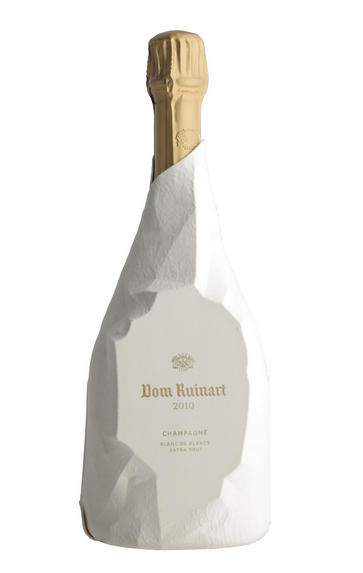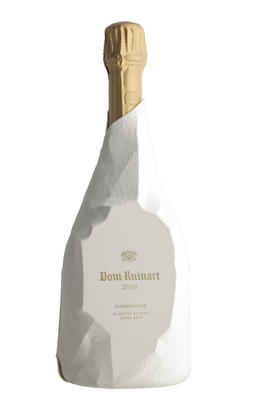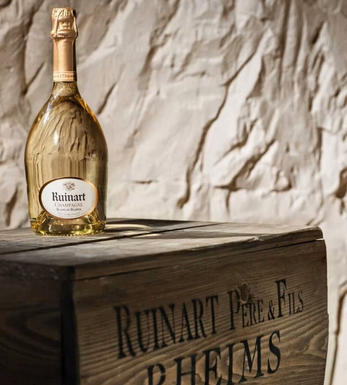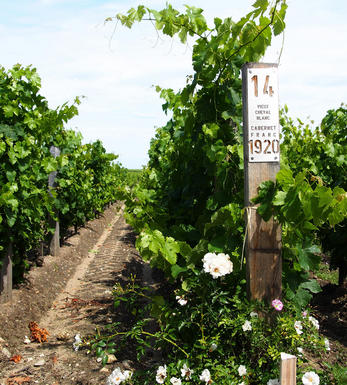
2010 Champagne Dom Ruinart, Second Skin, Blanc de Blancs, Brut

Critics reviews
The 2010 Dom Ruinart is genuinely epic. It’s also an eye-opening wine. And I do mean wine. Because the first impression is really of wine more than Champagne. The 2010 signalled a significant shift in philosophy, as Dom Ruinart is now aged entirely under cork (rather than crown seal) as it was back in the early 1960s.
Lemon peel, white flowers, mint, crushed rocks and white pepper all race across the palate, announcing a Champagne of stature, breed and pure class. All the elements build as the 2010 crescendos into its intensely saline, mineral-drenched finish. The low dosage of 4 grams per litre is perfectly judged.
I try to avoid the tired clichés that make comparisons with Burgundy, but it is impossible here. The best way I can describe the 2010 Dom Ruinart is that it tastes like a great Corton-Charlemagne with bubbles. Chef de Caves Frédéric Panaïotis has poured his heart and soul into Ruinart since arriving in 2007. He richly deserves all the accolades he will surely garner for this masterpiece, an achievement made all the more notable by the challenges of the growing season.
The 2010 Dom Ruinart is unreal. That’s all there is to it.
Disgorged: 2020
Drink 2028 - 2050
Antonio Galloni, Vinous.com (May 2022)
The first vintage of Dom Ruinart to have been aged under natural cork rather than a crown cap. 2010 was a cooler and wetter summer than 2009 – ‘almost like a traditional year’, according to chef de cave Frédéric Panaïotis, adding that this was ‘not a bad thing to have’.
They started picking on 14 September, but then the rains got worse, so only 10% of Montagne de Reims (Sillery) Chardonnay was included in 2010, so 90% is composed of the top grands crus of the Côte des Blancs. 10.4% potential alcohol (average 9.9%). Hand-disgorged in November 2020 with a dosage of 4 g/l.
Really deep flavoured. Very obviously has more depth of flavour and tension than the 2009 Dom Ruinart. The cork ageing does seem to enhance the savoury, reduced character reminiscent of white burgundy. Very long with lemon notes. A truly exciting wine that is still extremely youthful.
Drink 2022 - 2034
Jancis Robinson MW, JancisRobinson.com (May 2022)
Delicate nutty expressions of blanched almonds and warm biscuits on the nose, accompanied by notes of lemon oil, spring flowers, pastry, pear and exotic fruit. A hint of reduction in the form of a smoky element, attributable to the fact that the cellar ageing of this Champagne was carried out under cork rather than with the usual crown cap.
On the palate, this Champagne is medium- to full-bodied and well-balanced, with good textural vinosity, but there is also delicacy thanks to its pinpoint mousse. There is a mouthwatering touch of bitterness on the long, resonating finish.
This is a Champagne with real ageing potential with the powerful character and elegance of a Burgundy grand cru wine. 100% Chardonnay is sourced from Le Mesnil-sur-Oger, Avize, Chouilly and Cramant (90%) and 10% from Sillery, situated northeast of the Montagne de Reims sector.
Dosage: 4g/l
Drink 2022 - 2050
Yohan Castaing, Decanter.com (June 2022)
About this WINE

Champagne Ruinart
Ruinart is a low profile, yet select, Champagne house which is steeped in history. It dates back to the 17th century, the time of the famous Dom Pérignon. It was founded in 1729 by Nicolas Ruinart in the city of Reims, the year after a Royal Decree in 1728 whereby Louis XV gave his consent for sparkling wines to be shipped in baskets containing 50 to 100 bottles. This opened the gates of Europe to champagne and thus makes Ruinart the oldest Champagne House. Nicolas' uncle was Dom Thierry Ruinart, close friend to Dom Pérignon himself and an inspiration behind the creation of this house after the Dom’s death. Its Gallo-Roman chalk cellars are now a UNESCO-classified historical monument and every two years the finest sommeliers in Europe gather there to compete for the Trophée Ruinart.
Since the second world war the house has become synonymous with class and its production of only 1.7 million bottles per annum is small compared to other grande marques. It is now part of the LVMH group that also owns Moët & Chandon.
The house style emphasises the pre-eminence of Chardonnay over Pinot Noir and Pinot Meunier.
The 'R' de Ruinart NV contains 40% Chardonnay minimum, with 25% reserve wines. Ruinart Blanc de Blancs is 100% Chardonnay, sourced predominantly from Premier Cru vineyards, while Ruinart Brut Rosé is typically 45% Chardonnay and 55% Pinot, of which 18% is red wine, so following the assemblage, rather than the saignée method of rosé production.
The Dom Ruinart range, named for the spiritual father of the House, represents the prestige cuvées of the house. Dom Ruinart Blanc de Blancs is a Grand Cru Chardonnay, predominantly from the Côte des Blancs (70%) and the remainder from the Montagne de Reims.
Dom Ruinart Rosé champagne has the same basis as the Blanc de Blancs (Chardonnay) to which 15%-20% red wine (Pinot Noir from Verzenay and Verzy) has been added. These are amazingly rich and pure in youth developing red Burgundian notes with long ageing such as in the 1988 or 1990 vintages.

Blanc de Blancs
In Champagne, the term Blanc de Blancs designates Champagnes made only from Chardonnay grapes. The vineyards located between Cramant and Mesnil-sur-Oger in Cote de Blancs yield the best examples of the style.
A classic Blanc de Blancs is restrained and elegant when young, yet with ageing it develops a mouth-coating brioche richness that overlays an intense expression of fruitiness. Blanc de Blancs are endowed with longer ageing potential than a typical Blanc de Noirs.
Recommended Producers: Salon, Billecart Salmon, Jacques Selosse, Dom Ruinart, Krug, Le Mesnil Grand Cru, Guy Larmandier

Chardonnay
Chardonnay is often seen as the king of white wine grapes and one of the most widely planted in the world It is suited to a wide variety of soils, though it excels in soils with a high limestone content as found in Champagne, Chablis, and the Côte D`Or.
Burgundy is Chardonnay's spiritual home and the best White Burgundies are dry, rich, honeyed wines with marvellous poise, elegance and balance. They are unquestionably the finest dry white wines in the world. Chardonnay plays a crucial role in the Champagne blend, providing structure and finesse, and is the sole grape in Blanc de Blancs.
It is quantitatively important in California and Australia, is widely planted in Chile and South Africa, and is the second most widely planted grape in New Zealand. In warm climates Chardonnay has a tendency to develop very high sugar levels during the final stages of ripening and this can occur at the expense of acidity. Late picking is a common problem and can result in blowsy and flabby wines that lack structure and definition.
Recently in the New World, we have seen a move towards more elegant, better- balanced and less oak-driven Chardonnays, and this is to be welcomed.


Buying options
Add to wishlist
Description
The 2010 Dom Ruinart is genuinely epic. It’s also an eye-opening wine. And I do mean wine. Because the first impression is really of wine more than Champagne. The 2010 signalled a significant shift in philosophy, as Dom Ruinart is now aged entirely under cork (rather than crown seal) as it was back in the early 1960s.
Lemon peel, white flowers, mint, crushed rocks and white pepper all race across the palate, announcing a Champagne of stature, breed and pure class. All the elements build as the 2010 crescendos into its intensely saline, mineral-drenched finish. The low dosage of 4 grams per litre is perfectly judged.
I try to avoid the tired clichés that make comparisons with Burgundy, but it is impossible here. The best way I can describe the 2010 Dom Ruinart is that it tastes like a great Corton-Charlemagne with bubbles. Chef de Caves Frédéric Panaïotis has poured his heart and soul into Ruinart since arriving in 2007. He richly deserves all the accolades he will surely garner for this masterpiece, an achievement made all the more notable by the challenges of the growing season.
The 2010 Dom Ruinart is unreal. That’s all there is to it.
Disgorged: 2020
Drink 2028 - 2050
Antonio Galloni, Vinous.com (May 2022)
wine at a glance
Delivery and quality guarantee